- Context and Conception
My experience with the group project led me to conclude two things about interaction: first, some things “feel” more interactive than others. Second, an important factor in creating this interactive “feel” is having a piece that can speak the user’s language. The definition of interaction I used in that project was focused on the idea of communication. In this case, such thoughts inspired me to create a project that would “talk” to its user in some way. I took inspiration from the idea of the Magic 8 Ball. The Magic 8 Ball was an ideal place to start because, although the mechanism for the Magic 8 Ball is quite simple, the user experience has an interactive feeling. The user asks the ball a question, and in return are given an answer. Of course, my partner and I wanted to do something more than just a Magic 8 Ball. I find myself getting bored with the Magic 8 Ball after a few uses, mostly because the answers are simply too predictable. My partner (Alison Frank) and I decided to create a project which would give a set of answers which had more of an engaging, human character to them.
- Design
My partner and I began the design process by drafting a long set of answers which we could use in the project. These answers were originally quite long and some were quite mean – based on this, we decided that we wanted to create something stereotypically cute and innocent-looking to contrast the sarcastic answers. Like the Magic 8 Ball, we wanted it to be round with a small window for the answers to appear. Ours, however, would have some features to create a character, which we felt would be more engaging and create more of an interactive “feel.” We decided we wanted to use cardboard to create a base which would hide the circuitry and host a button: this was done mostly for convenience sake, as we knew the upper piece which would conceal the answers would take more care to create. A lot of this first draft influenced our final project: the “two-box” structure, the button, and the concept of a stepper-motor were all integral to our final design.
Our initial sketches:
The very first sketch we did. We changed the shape and placement of the button/window, but kept the idea of a stepper motor and two boxes to cover the wiring/motor.
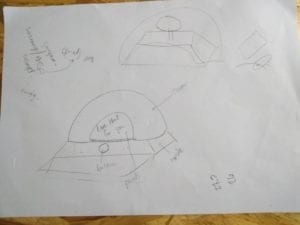
Our initial design for the “cute character” element which would go on the cover.
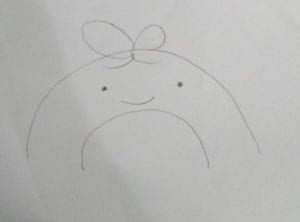
A slip of paper we used as a placeholder for the final thing. We ended up adding many more answers and printing the final one.
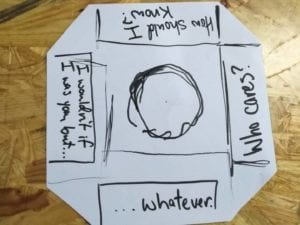
- Fabrication and Evolution of Design
Despite this first sketch’s influence, we immediately realized we would have trouble with it. The stepper motor which we had used in recitation was a decent choice but creating a circular object to go on top of it was giving us trouble. For this reason, we changed the circular top to another box. We fabricated the top box to have a window for the answers to appear in. Although this design worked decently, we had lost much of the character that we originally wanted. Users could press a button and get an answer from the project, but there was no real sense of interaction. At this point, we received advice from Professor Rudi about creating a theme which would mimic fortune-telling carnival booths. By adding a mannequin head and concealing the button with a deck of cards, the aesthetic of the project (and subsequently the experience of using it) was changed completely. It was at this point that we found a title for the project: “The Mystical Aunt Margot.” Rather than a “mean” Magic 8 Ball, we had created a fortune-telling machine which replaced the genie figure with a (somewhat incompetent) aunt.
Some photos of this process:
The placement of the head (with shirt as a wrap and my sunglasses to cover the face) and the sketch that I made to estimate what a final product might look like incorporating it.
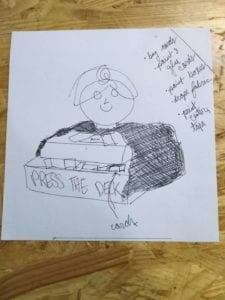
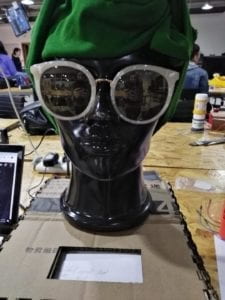
The bottom box — the backside, which shows how the wiring fits into it, and then the top with the motor placed in its place.
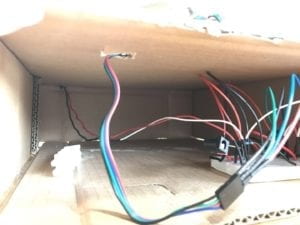
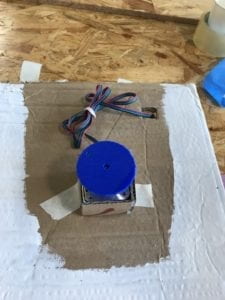
The motor with the slip of answers placed on top (sans cover).
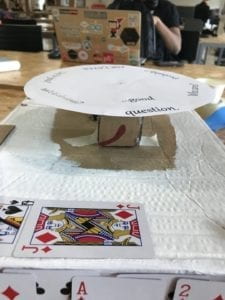
The working of the final product. Notice the way it lands incorrectly between answers before correcting itself.
The final steps of the project were all taken in response to the user testing. Some feedback was easily implemented: the window which revealed the answers, for example, was too small. This was fixed by simply cutting the window to be wider. Another issue was that some users simply had no idea how they were to use the project. My partner and I had assumed that everyone would be familiar with the Magic 8 Ball concept: while some users immediately knew what to do with the project, some were completely lost. This led us to include a speech bubble with instructions on how to use the project. Although we were given some easy fixes, there were some tougher issues we had to face. In terms of the user experience, some felt that the button was too arbitrary. One piece of advice was to create a mechanism which would make the project give an answer based on picking up a card. Due to time constraints, my partner and I decided we could not realistically implement such a mechanism. Our struggles based on time were due to the last issue we encountered during user testing: our answers would often not spin evenly, leaving every few button spins landing in-between answers rather than revealing only one. At first we considered that this might be a hardware issue: we replaced the foam disk we had used to support our answers with a lighter cardboard one. This helped a bit, but still did not fix the issue. My partner was busy most of the weekend but gave some advice over messaging about fixing the problem by mapping our array values onto the number of steps in the stepper motor. With some help from a fellow we got closer to fixing the problem, mostly by adjusting the delay between spins and adjusting the values within the arrays which would determine the steps the motor would move. Still, our final project occasionally got off. Given more time, I would hope to sit down with my partner and finally figure out why this problem persisted.
- Conclusions
My partner and I intended to create a project which would create an interactive, fun experience for the user. In the end I do believe we came very close to fulfilling that goal with our “Mystical Aunt,” in that our project has its own clear aesthetic which invites the user to, in short, play with it. I could see this project existing in a shopping mall or diner as a small toy, a gadget that users could put a coin into to get a fortune. Given more time, I think it would be very fun to add some decorative flairs, perhaps some lights that flash when the disk spins or some kind of voice recording that tells a user how to play when they step up to the device. It might even be fun to get rid of the disk altogether and just have a random voice message play after the button is pressed. Going ahead, I will keep these possibilities in mind for the final project.
I learned two major things from this project experience: First, when designing I should try to consider how people of different backgrounds would approach the project. My partner and I were both very familiar with the Magic 8 Ball and similar devices, but while user testing we found that this was not true for everyone. Second, I personally learned that it is okay to have to change things. I was very set on our initial idea, so when those things did not work out I did not know where to go. However, after talking with Professor Rudi I realized that I could very easily make something cool out of what I had already built. Next time I hope that when I have to abandon plans I can use the opportunity to improve and make something cool instead of feeling that I have to build towards my original concept. Moving into the final project, I have a better concept in mind of how to build something with an interactive “feel” that can entice people of all backgrounds, and more strategies for working with setbacks to turn them into opportunities for new development.